Johnson & Johnson: Macro-Environment and Competitive Analysis Report
VerifiedAdded on 2022/09/10
|18
|4340
|29
Report
AI Summary
This report offers a comprehensive analysis of Johnson & Johnson's competitive environment within the US pharmaceutical industry. It begins with a PESTLE analysis to assess the macro-environmental factors, including political, economic, social, technological, legal, and environmental influences. The report then applies Porter's Five Forces model to evaluate the industry's competitive landscape, examining the bargaining power of buyers and suppliers, the intensity of competitive rivalry, the threat of new entrants, and the threat of substitutes. Furthermore, the analysis delves into Johnson & Johnson's competitive advantages, strategies, and resources and capabilities, considering theories of competitive advantage and the company's strategic approach. The report concludes with a self-reflection on the skills developed through the analysis of the provided materials.
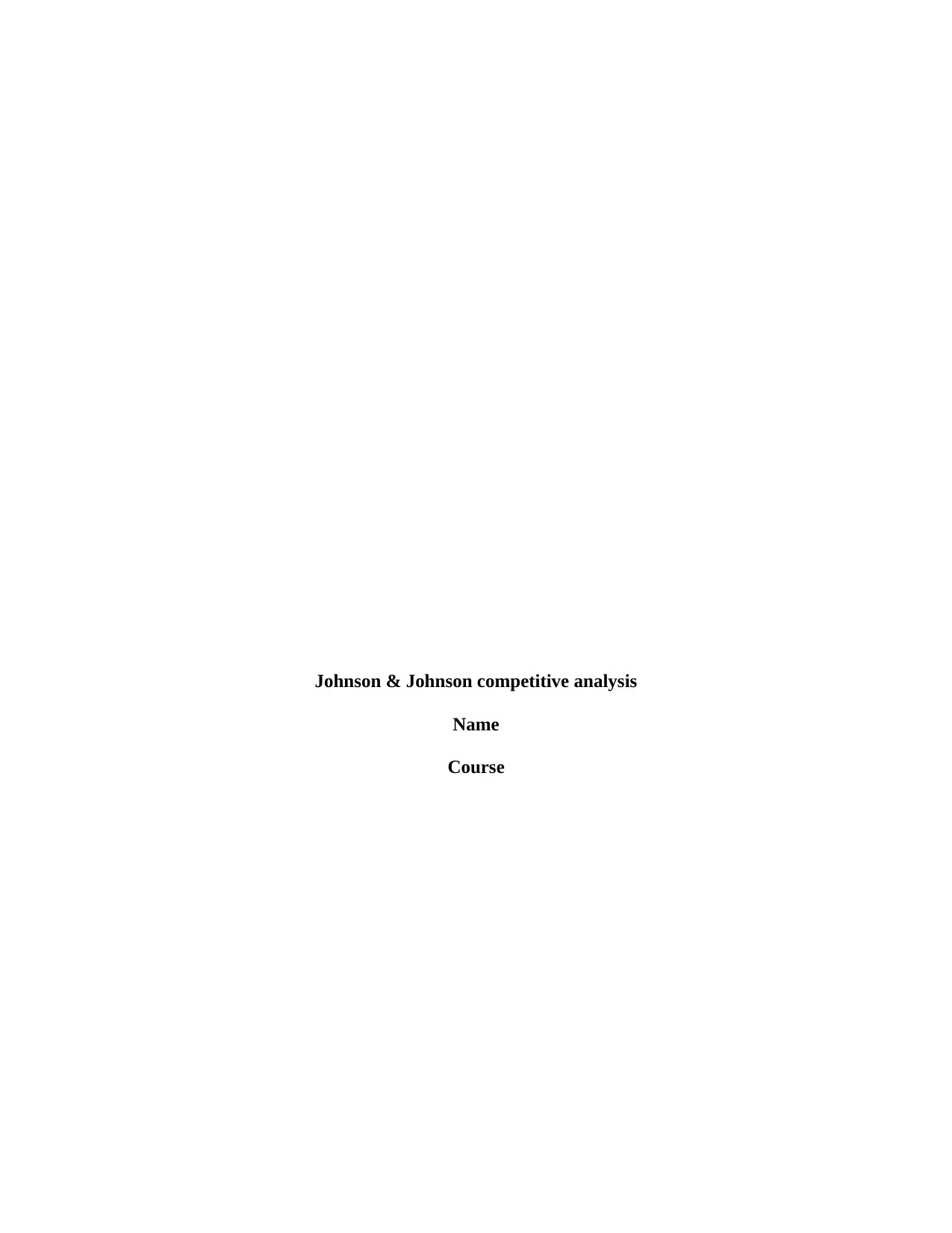
Johnson & Johnson competitive analysis
Name
Course
Name
Course
Paraphrase This Document
Need a fresh take? Get an instant paraphrase of this document with our AI Paraphraser
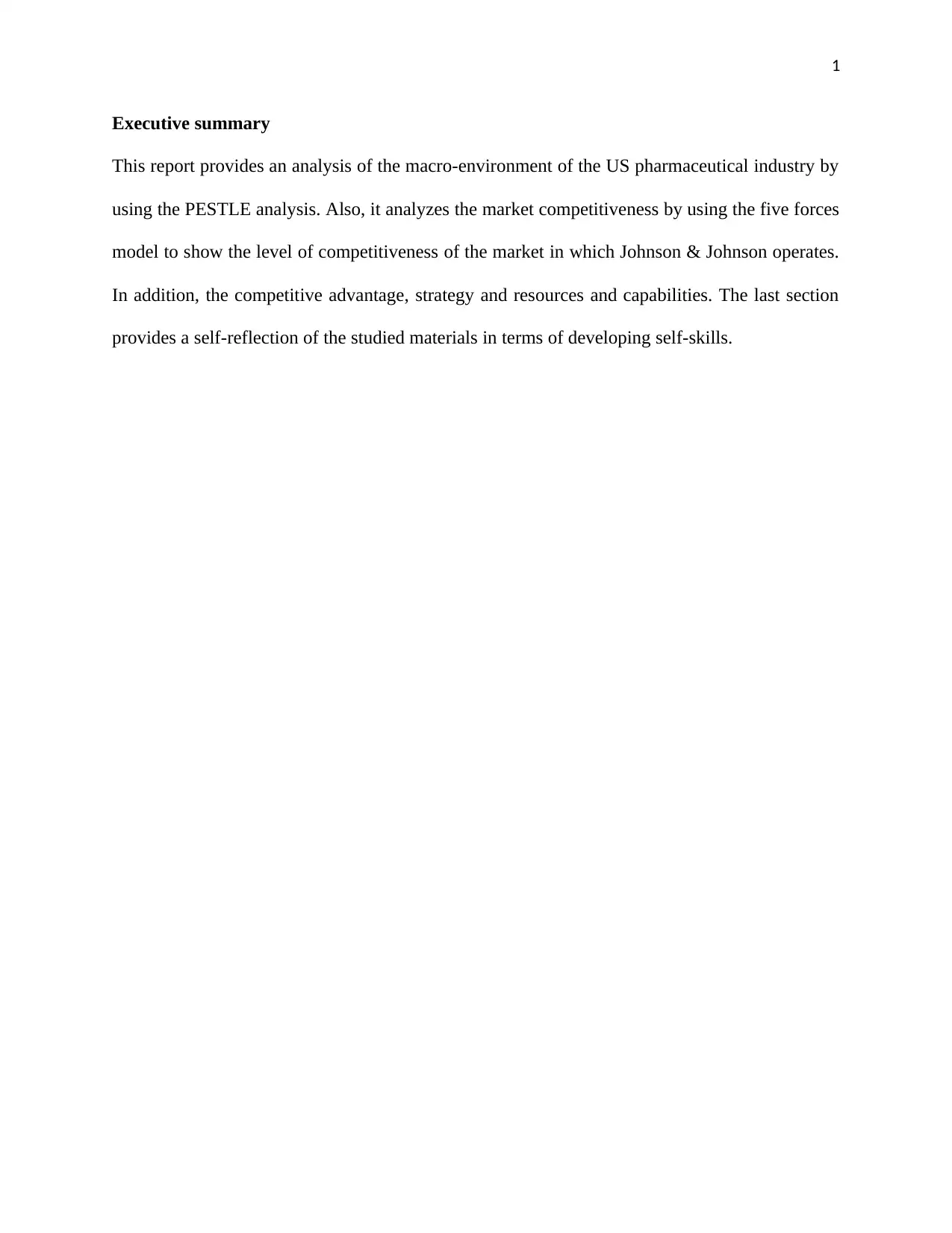
1
Executive summary
This report provides an analysis of the macro-environment of the US pharmaceutical industry by
using the PESTLE analysis. Also, it analyzes the market competitiveness by using the five forces
model to show the level of competitiveness of the market in which Johnson & Johnson operates.
In addition, the competitive advantage, strategy and resources and capabilities. The last section
provides a self-reflection of the studied materials in terms of developing self-skills.
Executive summary
This report provides an analysis of the macro-environment of the US pharmaceutical industry by
using the PESTLE analysis. Also, it analyzes the market competitiveness by using the five forces
model to show the level of competitiveness of the market in which Johnson & Johnson operates.
In addition, the competitive advantage, strategy and resources and capabilities. The last section
provides a self-reflection of the studied materials in terms of developing self-skills.
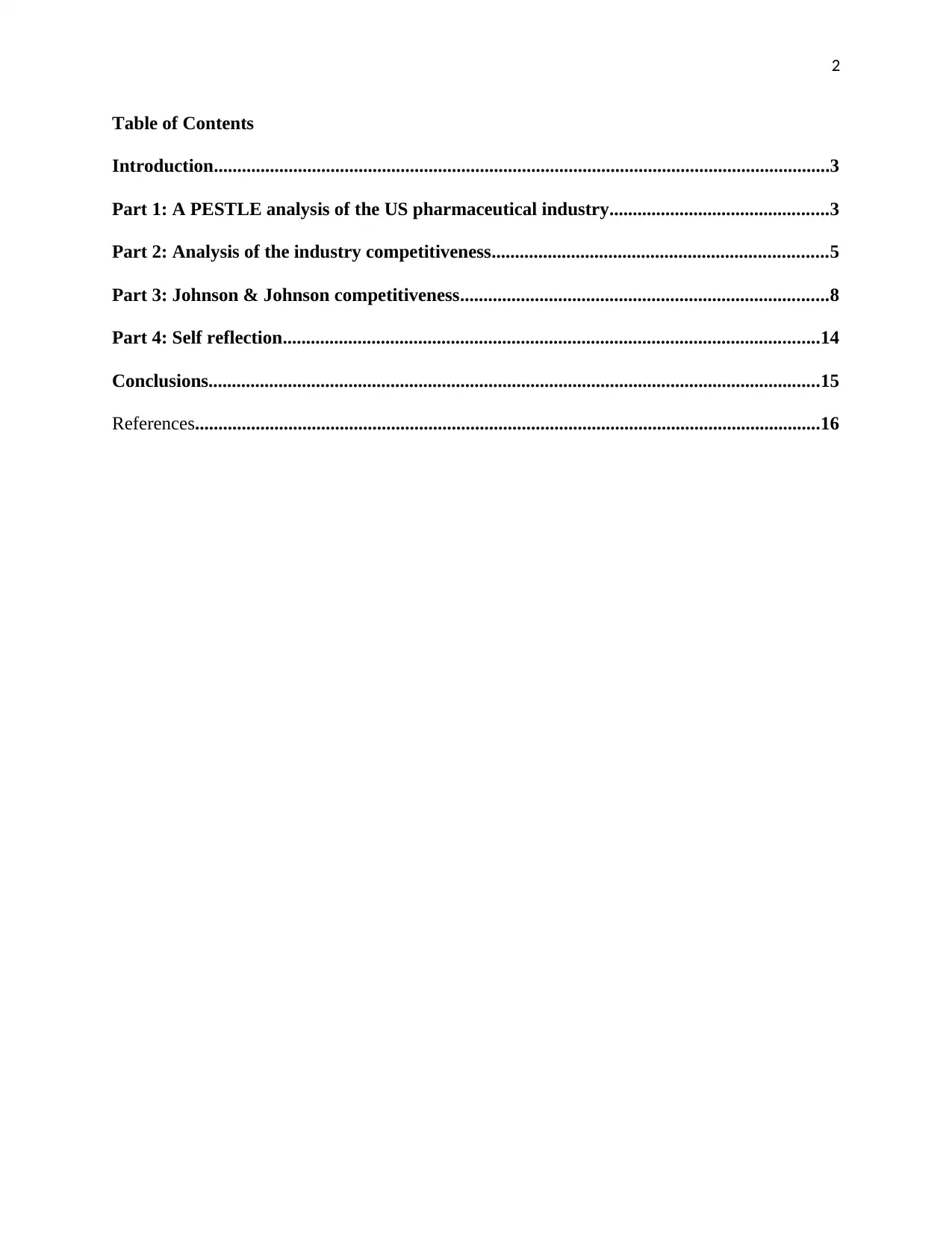
2
Table of Contents
Introduction....................................................................................................................................3
Part 1: A PESTLE analysis of the US pharmaceutical industry...............................................3
Part 2: Analysis of the industry competitiveness........................................................................5
Part 3: Johnson & Johnson competitiveness...............................................................................8
Part 4: Self reflection...................................................................................................................14
Conclusions...................................................................................................................................15
References......................................................................................................................................16
Table of Contents
Introduction....................................................................................................................................3
Part 1: A PESTLE analysis of the US pharmaceutical industry...............................................3
Part 2: Analysis of the industry competitiveness........................................................................5
Part 3: Johnson & Johnson competitiveness...............................................................................8
Part 4: Self reflection...................................................................................................................14
Conclusions...................................................................................................................................15
References......................................................................................................................................16
⊘ This is a preview!⊘
Do you want full access?
Subscribe today to unlock all pages.

Trusted by 1+ million students worldwide
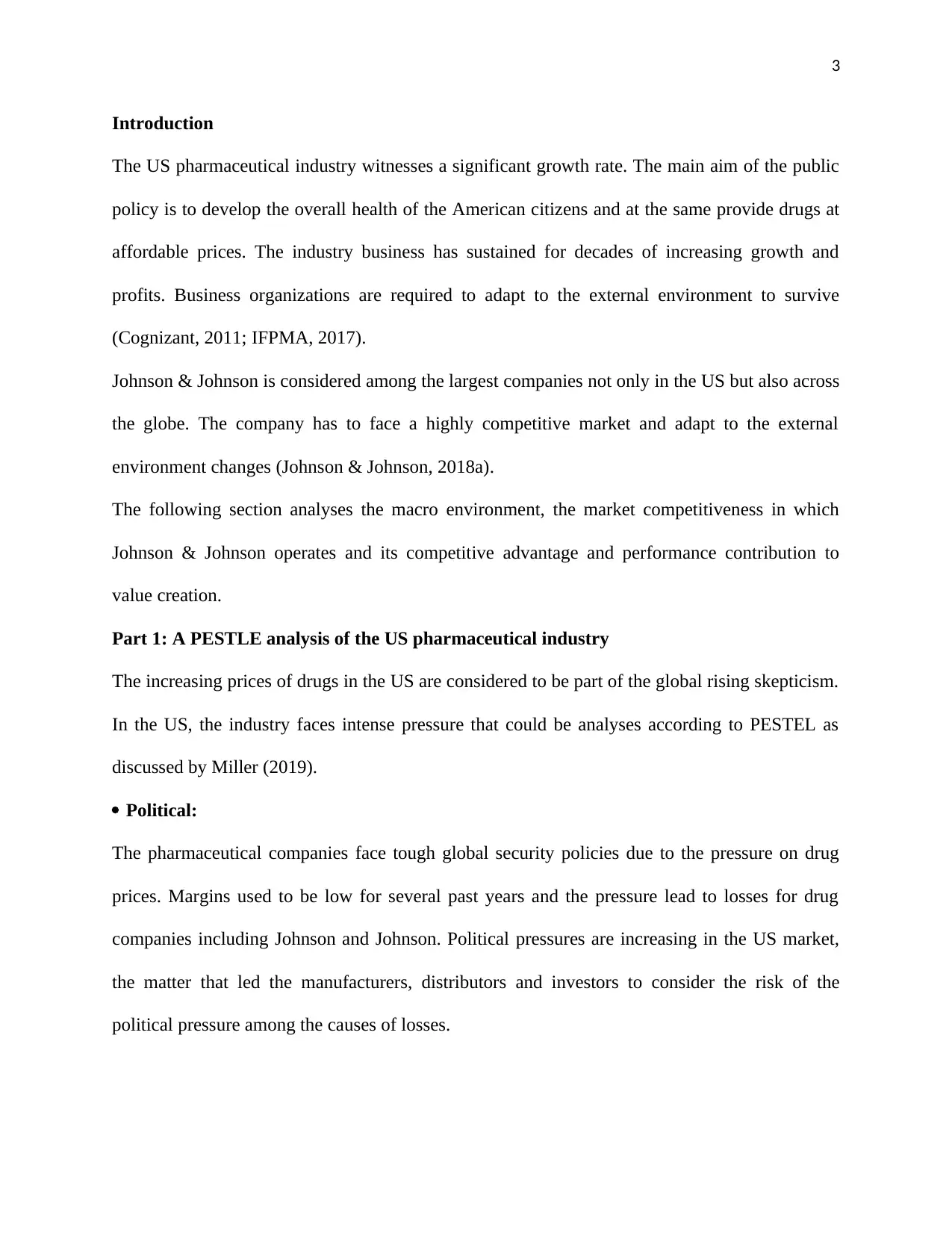
3
Introduction
The US pharmaceutical industry witnesses a significant growth rate. The main aim of the public
policy is to develop the overall health of the American citizens and at the same provide drugs at
affordable prices. The industry business has sustained for decades of increasing growth and
profits. Business organizations are required to adapt to the external environment to survive
(Cognizant, 2011; IFPMA, 2017).
Johnson & Johnson is considered among the largest companies not only in the US but also across
the globe. The company has to face a highly competitive market and adapt to the external
environment changes (Johnson & Johnson, 2018a).
The following section analyses the macro environment, the market competitiveness in which
Johnson & Johnson operates and its competitive advantage and performance contribution to
value creation.
Part 1: A PESTLE analysis of the US pharmaceutical industry
The increasing prices of drugs in the US are considered to be part of the global rising skepticism.
In the US, the industry faces intense pressure that could be analyses according to PESTEL as
discussed by Miller (2019).
Political:
The pharmaceutical companies face tough global security policies due to the pressure on drug
prices. Margins used to be low for several past years and the pressure lead to losses for drug
companies including Johnson and Johnson. Political pressures are increasing in the US market,
the matter that led the manufacturers, distributors and investors to consider the risk of the
political pressure among the causes of losses.
Introduction
The US pharmaceutical industry witnesses a significant growth rate. The main aim of the public
policy is to develop the overall health of the American citizens and at the same provide drugs at
affordable prices. The industry business has sustained for decades of increasing growth and
profits. Business organizations are required to adapt to the external environment to survive
(Cognizant, 2011; IFPMA, 2017).
Johnson & Johnson is considered among the largest companies not only in the US but also across
the globe. The company has to face a highly competitive market and adapt to the external
environment changes (Johnson & Johnson, 2018a).
The following section analyses the macro environment, the market competitiveness in which
Johnson & Johnson operates and its competitive advantage and performance contribution to
value creation.
Part 1: A PESTLE analysis of the US pharmaceutical industry
The increasing prices of drugs in the US are considered to be part of the global rising skepticism.
In the US, the industry faces intense pressure that could be analyses according to PESTEL as
discussed by Miller (2019).
Political:
The pharmaceutical companies face tough global security policies due to the pressure on drug
prices. Margins used to be low for several past years and the pressure lead to losses for drug
companies including Johnson and Johnson. Political pressures are increasing in the US market,
the matter that led the manufacturers, distributors and investors to consider the risk of the
political pressure among the causes of losses.
Paraphrase This Document
Need a fresh take? Get an instant paraphrase of this document with our AI Paraphraser
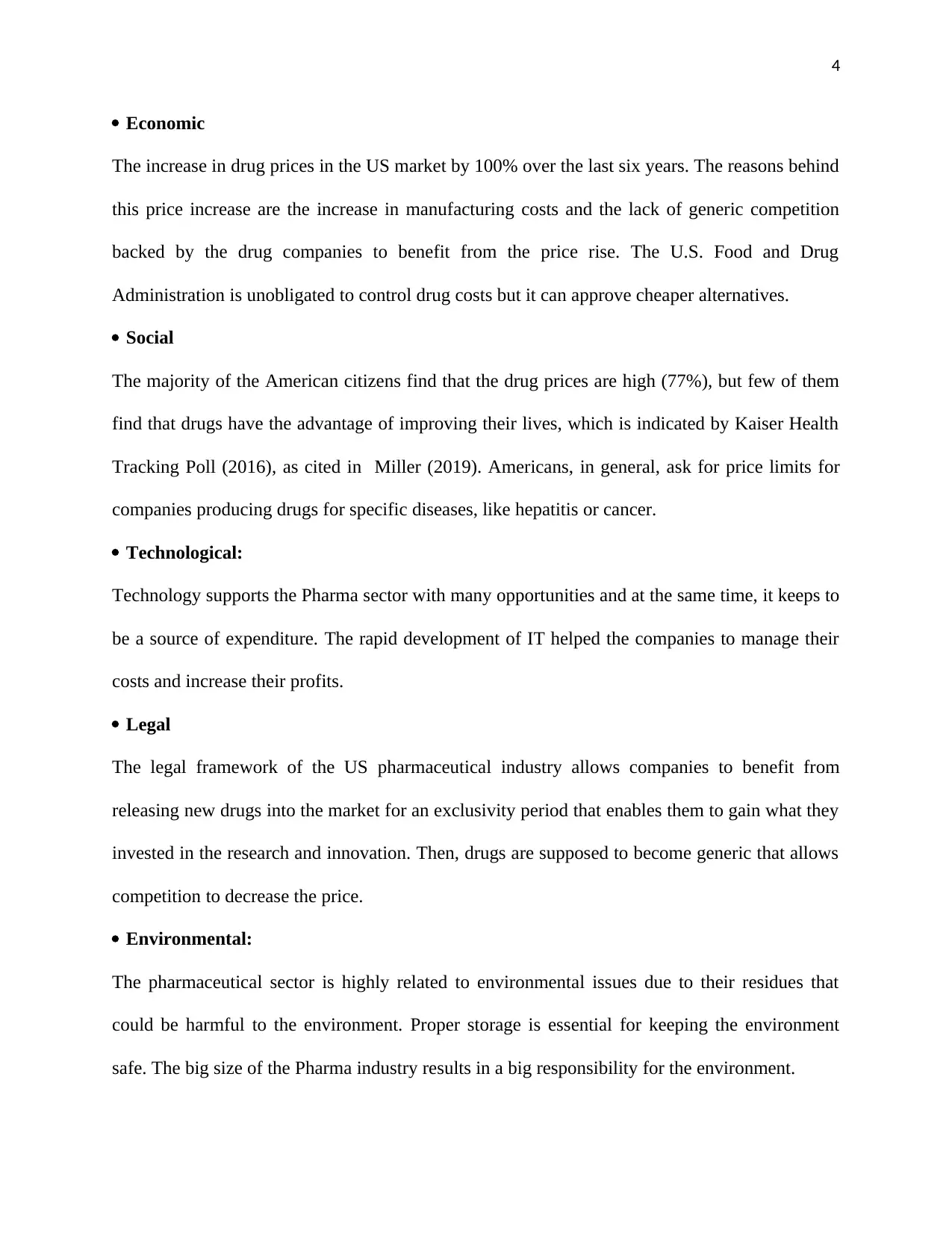
4
Economic
The increase in drug prices in the US market by 100% over the last six years. The reasons behind
this price increase are the increase in manufacturing costs and the lack of generic competition
backed by the drug companies to benefit from the price rise. The U.S. Food and Drug
Administration is unobligated to control drug costs but it can approve cheaper alternatives.
Social
The majority of the American citizens find that the drug prices are high (77%), but few of them
find that drugs have the advantage of improving their lives, which is indicated by Kaiser Health
Tracking Poll (2016), as cited in Miller (2019). Americans, in general, ask for price limits for
companies producing drugs for specific diseases, like hepatitis or cancer.
Technological:
Technology supports the Pharma sector with many opportunities and at the same time, it keeps to
be a source of expenditure. The rapid development of IT helped the companies to manage their
costs and increase their profits.
Legal
The legal framework of the US pharmaceutical industry allows companies to benefit from
releasing new drugs into the market for an exclusivity period that enables them to gain what they
invested in the research and innovation. Then, drugs are supposed to become generic that allows
competition to decrease the price.
Environmental:
The pharmaceutical sector is highly related to environmental issues due to their residues that
could be harmful to the environment. Proper storage is essential for keeping the environment
safe. The big size of the Pharma industry results in a big responsibility for the environment.
Economic
The increase in drug prices in the US market by 100% over the last six years. The reasons behind
this price increase are the increase in manufacturing costs and the lack of generic competition
backed by the drug companies to benefit from the price rise. The U.S. Food and Drug
Administration is unobligated to control drug costs but it can approve cheaper alternatives.
Social
The majority of the American citizens find that the drug prices are high (77%), but few of them
find that drugs have the advantage of improving their lives, which is indicated by Kaiser Health
Tracking Poll (2016), as cited in Miller (2019). Americans, in general, ask for price limits for
companies producing drugs for specific diseases, like hepatitis or cancer.
Technological:
Technology supports the Pharma sector with many opportunities and at the same time, it keeps to
be a source of expenditure. The rapid development of IT helped the companies to manage their
costs and increase their profits.
Legal
The legal framework of the US pharmaceutical industry allows companies to benefit from
releasing new drugs into the market for an exclusivity period that enables them to gain what they
invested in the research and innovation. Then, drugs are supposed to become generic that allows
competition to decrease the price.
Environmental:
The pharmaceutical sector is highly related to environmental issues due to their residues that
could be harmful to the environment. Proper storage is essential for keeping the environment
safe. The big size of the Pharma industry results in a big responsibility for the environment.
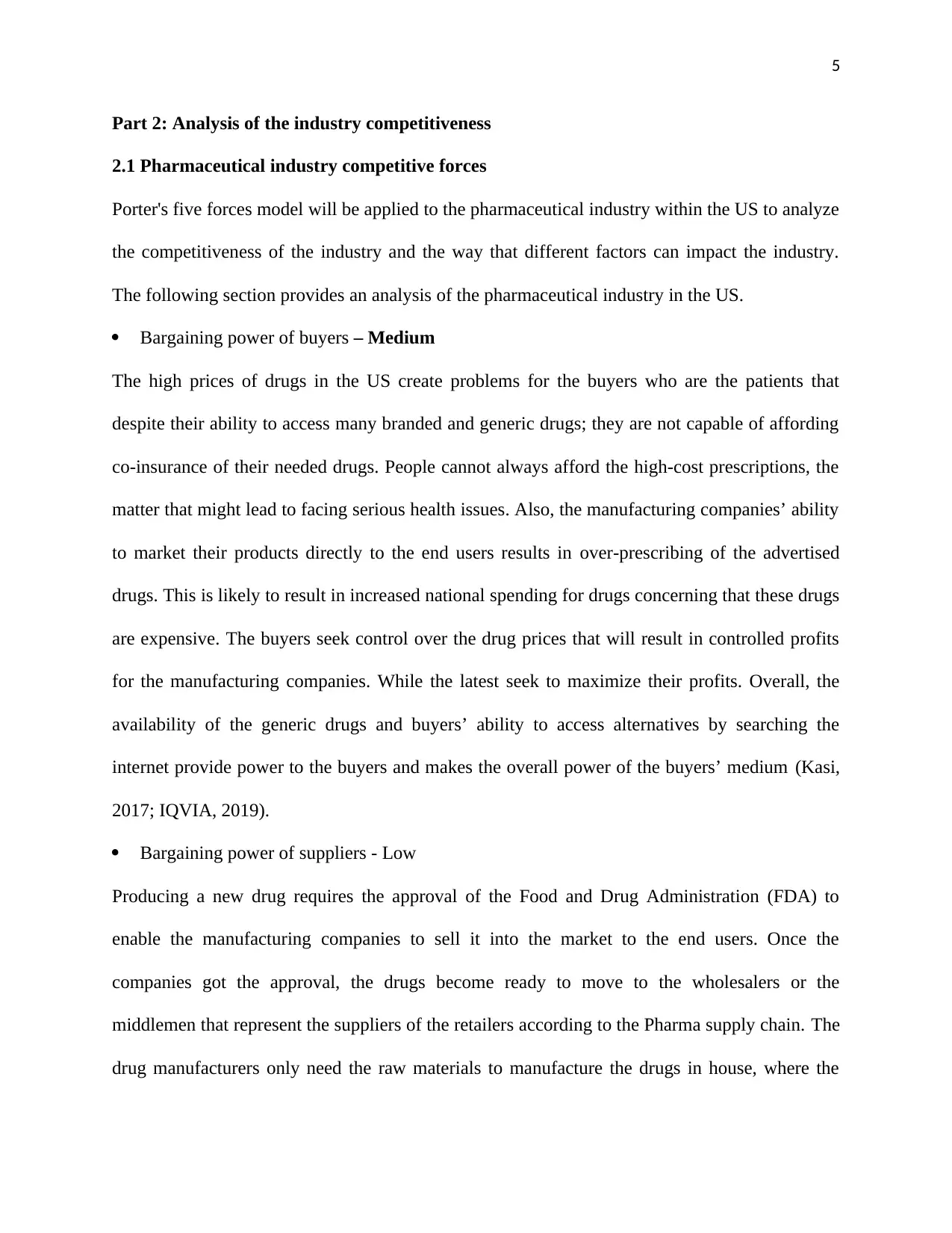
5
Part 2: Analysis of the industry competitiveness
2.1 Pharmaceutical industry competitive forces
Porter's five forces model will be applied to the pharmaceutical industry within the US to analyze
the competitiveness of the industry and the way that different factors can impact the industry.
The following section provides an analysis of the pharmaceutical industry in the US.
Bargaining power of buyers – Medium
The high prices of drugs in the US create problems for the buyers who are the patients that
despite their ability to access many branded and generic drugs; they are not capable of affording
co-insurance of their needed drugs. People cannot always afford the high-cost prescriptions, the
matter that might lead to facing serious health issues. Also, the manufacturing companies’ ability
to market their products directly to the end users results in over-prescribing of the advertised
drugs. This is likely to result in increased national spending for drugs concerning that these drugs
are expensive. The buyers seek control over the drug prices that will result in controlled profits
for the manufacturing companies. While the latest seek to maximize their profits. Overall, the
availability of the generic drugs and buyers’ ability to access alternatives by searching the
internet provide power to the buyers and makes the overall power of the buyers’ medium (Kasi,
2017; IQVIA, 2019).
Bargaining power of suppliers - Low
Producing a new drug requires the approval of the Food and Drug Administration (FDA) to
enable the manufacturing companies to sell it into the market to the end users. Once the
companies got the approval, the drugs become ready to move to the wholesalers or the
middlemen that represent the suppliers of the retailers according to the Pharma supply chain. The
drug manufacturers only need the raw materials to manufacture the drugs in house, where the
Part 2: Analysis of the industry competitiveness
2.1 Pharmaceutical industry competitive forces
Porter's five forces model will be applied to the pharmaceutical industry within the US to analyze
the competitiveness of the industry and the way that different factors can impact the industry.
The following section provides an analysis of the pharmaceutical industry in the US.
Bargaining power of buyers – Medium
The high prices of drugs in the US create problems for the buyers who are the patients that
despite their ability to access many branded and generic drugs; they are not capable of affording
co-insurance of their needed drugs. People cannot always afford the high-cost prescriptions, the
matter that might lead to facing serious health issues. Also, the manufacturing companies’ ability
to market their products directly to the end users results in over-prescribing of the advertised
drugs. This is likely to result in increased national spending for drugs concerning that these drugs
are expensive. The buyers seek control over the drug prices that will result in controlled profits
for the manufacturing companies. While the latest seek to maximize their profits. Overall, the
availability of the generic drugs and buyers’ ability to access alternatives by searching the
internet provide power to the buyers and makes the overall power of the buyers’ medium (Kasi,
2017; IQVIA, 2019).
Bargaining power of suppliers - Low
Producing a new drug requires the approval of the Food and Drug Administration (FDA) to
enable the manufacturing companies to sell it into the market to the end users. Once the
companies got the approval, the drugs become ready to move to the wholesalers or the
middlemen that represent the suppliers of the retailers according to the Pharma supply chain. The
drug manufacturers only need the raw materials to manufacture the drugs in house, where the
⊘ This is a preview!⊘
Do you want full access?
Subscribe today to unlock all pages.

Trusted by 1+ million students worldwide
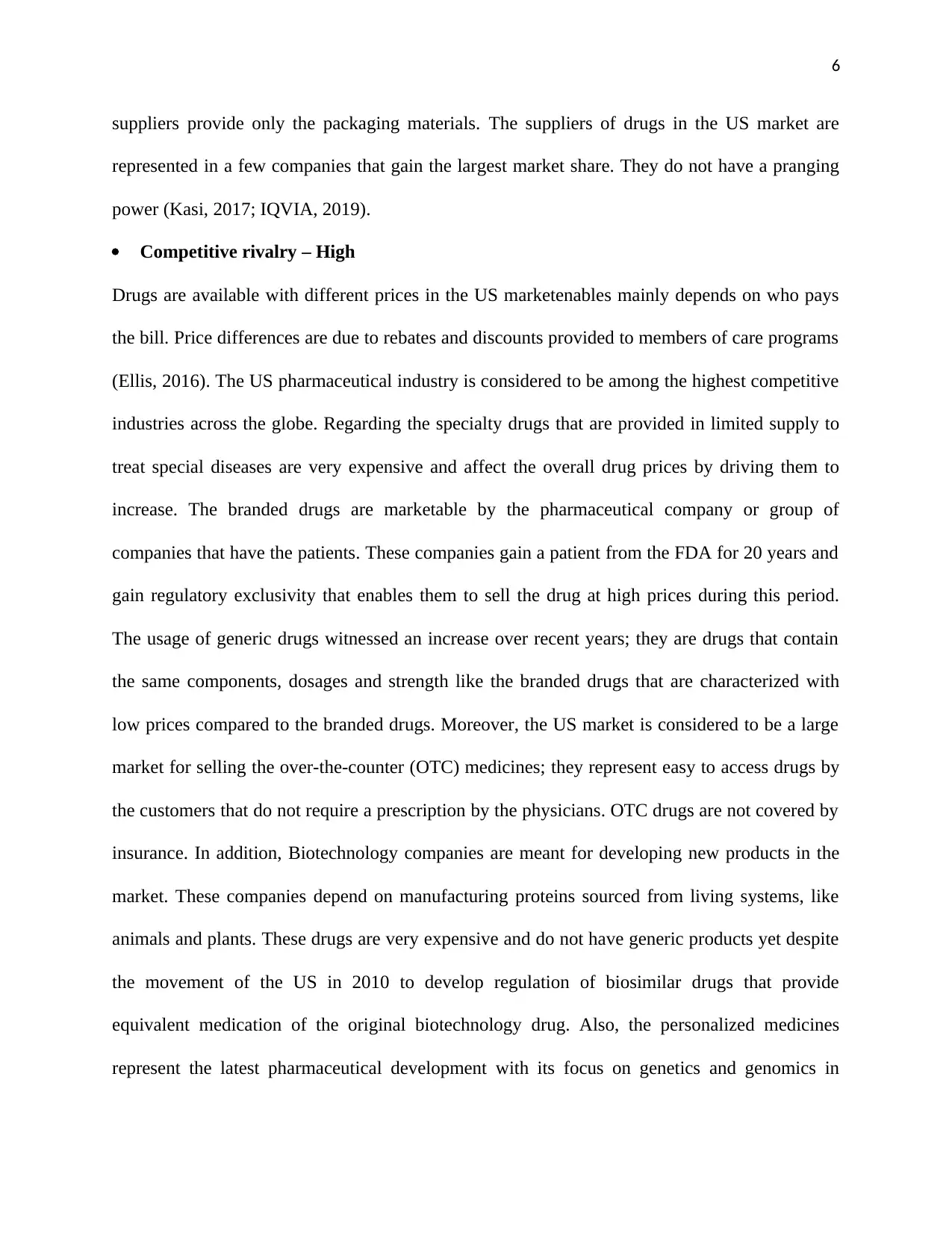
6
suppliers provide only the packaging materials. The suppliers of drugs in the US market are
represented in a few companies that gain the largest market share. They do not have a pranging
power (Kasi, 2017; IQVIA, 2019).
Competitive rivalry – High
Drugs are available with different prices in the US marketenables mainly depends on who pays
the bill. Price differences are due to rebates and discounts provided to members of care programs
(Ellis, 2016). The US pharmaceutical industry is considered to be among the highest competitive
industries across the globe. Regarding the specialty drugs that are provided in limited supply to
treat special diseases are very expensive and affect the overall drug prices by driving them to
increase. The branded drugs are marketable by the pharmaceutical company or group of
companies that have the patients. These companies gain a patient from the FDA for 20 years and
gain regulatory exclusivity that enables them to sell the drug at high prices during this period.
The usage of generic drugs witnessed an increase over recent years; they are drugs that contain
the same components, dosages and strength like the branded drugs that are characterized with
low prices compared to the branded drugs. Moreover, the US market is considered to be a large
market for selling the over-the-counter (OTC) medicines; they represent easy to access drugs by
the customers that do not require a prescription by the physicians. OTC drugs are not covered by
insurance. In addition, Biotechnology companies are meant for developing new products in the
market. These companies depend on manufacturing proteins sourced from living systems, like
animals and plants. These drugs are very expensive and do not have generic products yet despite
the movement of the US in 2010 to develop regulation of biosimilar drugs that provide
equivalent medication of the original biotechnology drug. Also, the personalized medicines
represent the latest pharmaceutical development with its focus on genetics and genomics in
suppliers provide only the packaging materials. The suppliers of drugs in the US market are
represented in a few companies that gain the largest market share. They do not have a pranging
power (Kasi, 2017; IQVIA, 2019).
Competitive rivalry – High
Drugs are available with different prices in the US marketenables mainly depends on who pays
the bill. Price differences are due to rebates and discounts provided to members of care programs
(Ellis, 2016). The US pharmaceutical industry is considered to be among the highest competitive
industries across the globe. Regarding the specialty drugs that are provided in limited supply to
treat special diseases are very expensive and affect the overall drug prices by driving them to
increase. The branded drugs are marketable by the pharmaceutical company or group of
companies that have the patients. These companies gain a patient from the FDA for 20 years and
gain regulatory exclusivity that enables them to sell the drug at high prices during this period.
The usage of generic drugs witnessed an increase over recent years; they are drugs that contain
the same components, dosages and strength like the branded drugs that are characterized with
low prices compared to the branded drugs. Moreover, the US market is considered to be a large
market for selling the over-the-counter (OTC) medicines; they represent easy to access drugs by
the customers that do not require a prescription by the physicians. OTC drugs are not covered by
insurance. In addition, Biotechnology companies are meant for developing new products in the
market. These companies depend on manufacturing proteins sourced from living systems, like
animals and plants. These drugs are very expensive and do not have generic products yet despite
the movement of the US in 2010 to develop regulation of biosimilar drugs that provide
equivalent medication of the original biotechnology drug. Also, the personalized medicines
represent the latest pharmaceutical development with its focus on genetics and genomics in
Paraphrase This Document
Need a fresh take? Get an instant paraphrase of this document with our AI Paraphraser
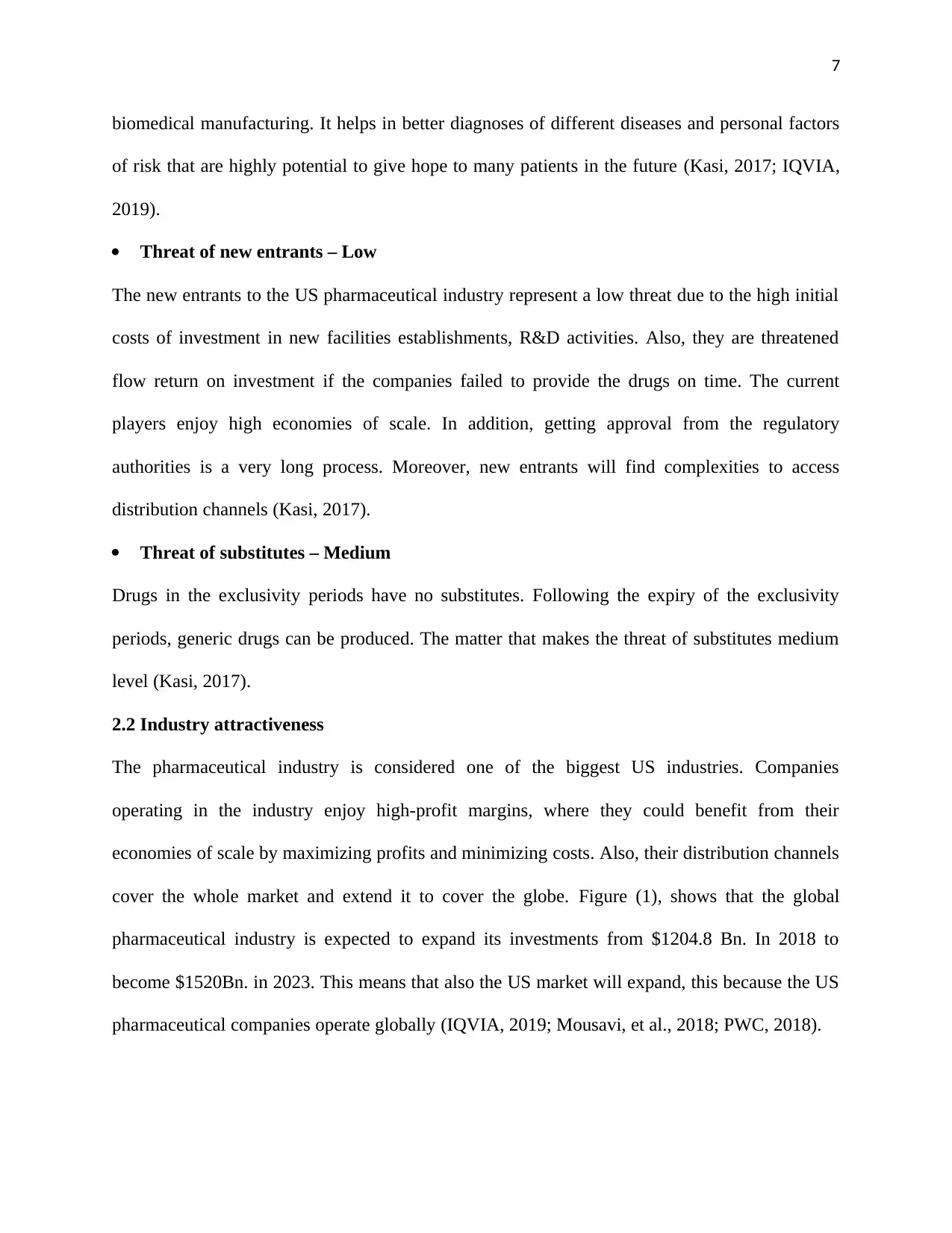
7
biomedical manufacturing. It helps in better diagnoses of different diseases and personal factors
of risk that are highly potential to give hope to many patients in the future (Kasi, 2017; IQVIA,
2019).
Threat of new entrants – Low
The new entrants to the US pharmaceutical industry represent a low threat due to the high initial
costs of investment in new facilities establishments, R&D activities. Also, they are threatened
flow return on investment if the companies failed to provide the drugs on time. The current
players enjoy high economies of scale. In addition, getting approval from the regulatory
authorities is a very long process. Moreover, new entrants will find complexities to access
distribution channels (Kasi, 2017).
Threat of substitutes – Medium
Drugs in the exclusivity periods have no substitutes. Following the expiry of the exclusivity
periods, generic drugs can be produced. The matter that makes the threat of substitutes medium
level (Kasi, 2017).
2.2 Industry attractiveness
The pharmaceutical industry is considered one of the biggest US industries. Companies
operating in the industry enjoy high-profit margins, where they could benefit from their
economies of scale by maximizing profits and minimizing costs. Also, their distribution channels
cover the whole market and extend it to cover the globe. Figure (1), shows that the global
pharmaceutical industry is expected to expand its investments from $1204.8 Bn. In 2018 to
become $1520Bn. in 2023. This means that also the US market will expand, this because the US
pharmaceutical companies operate globally (IQVIA, 2019; Mousavi, et al., 2018; PWC, 2018).
biomedical manufacturing. It helps in better diagnoses of different diseases and personal factors
of risk that are highly potential to give hope to many patients in the future (Kasi, 2017; IQVIA,
2019).
Threat of new entrants – Low
The new entrants to the US pharmaceutical industry represent a low threat due to the high initial
costs of investment in new facilities establishments, R&D activities. Also, they are threatened
flow return on investment if the companies failed to provide the drugs on time. The current
players enjoy high economies of scale. In addition, getting approval from the regulatory
authorities is a very long process. Moreover, new entrants will find complexities to access
distribution channels (Kasi, 2017).
Threat of substitutes – Medium
Drugs in the exclusivity periods have no substitutes. Following the expiry of the exclusivity
periods, generic drugs can be produced. The matter that makes the threat of substitutes medium
level (Kasi, 2017).
2.2 Industry attractiveness
The pharmaceutical industry is considered one of the biggest US industries. Companies
operating in the industry enjoy high-profit margins, where they could benefit from their
economies of scale by maximizing profits and minimizing costs. Also, their distribution channels
cover the whole market and extend it to cover the globe. Figure (1), shows that the global
pharmaceutical industry is expected to expand its investments from $1204.8 Bn. In 2018 to
become $1520Bn. in 2023. This means that also the US market will expand, this because the US
pharmaceutical companies operate globally (IQVIA, 2019; Mousavi, et al., 2018; PWC, 2018).
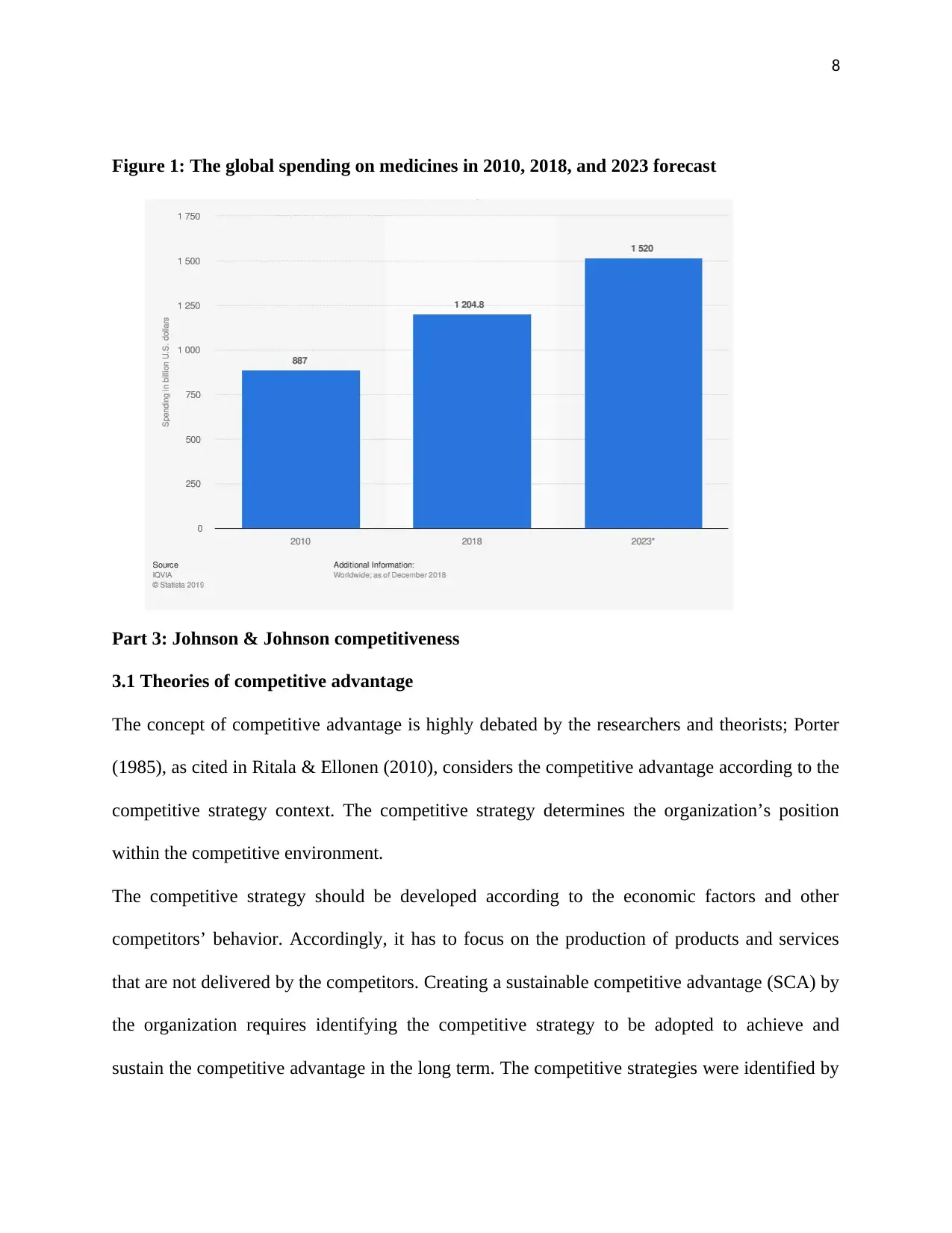
8
Figure 1: The global spending on medicines in 2010, 2018, and 2023 forecast
Part 3: Johnson & Johnson competitiveness
3.1 Theories of competitive advantage
The concept of competitive advantage is highly debated by the researchers and theorists; Porter
(1985), as cited in Ritala & Ellonen (2010), considers the competitive advantage according to the
competitive strategy context. The competitive strategy determines the organization’s position
within the competitive environment.
The competitive strategy should be developed according to the economic factors and other
competitors’ behavior. Accordingly, it has to focus on the production of products and services
that are not delivered by the competitors. Creating a sustainable competitive advantage (SCA) by
the organization requires identifying the competitive strategy to be adopted to achieve and
sustain the competitive advantage in the long term. The competitive strategies were identified by
Figure 1: The global spending on medicines in 2010, 2018, and 2023 forecast
Part 3: Johnson & Johnson competitiveness
3.1 Theories of competitive advantage
The concept of competitive advantage is highly debated by the researchers and theorists; Porter
(1985), as cited in Ritala & Ellonen (2010), considers the competitive advantage according to the
competitive strategy context. The competitive strategy determines the organization’s position
within the competitive environment.
The competitive strategy should be developed according to the economic factors and other
competitors’ behavior. Accordingly, it has to focus on the production of products and services
that are not delivered by the competitors. Creating a sustainable competitive advantage (SCA) by
the organization requires identifying the competitive strategy to be adopted to achieve and
sustain the competitive advantage in the long term. The competitive strategies were identified by
⊘ This is a preview!⊘
Do you want full access?
Subscribe today to unlock all pages.

Trusted by 1+ million students worldwide
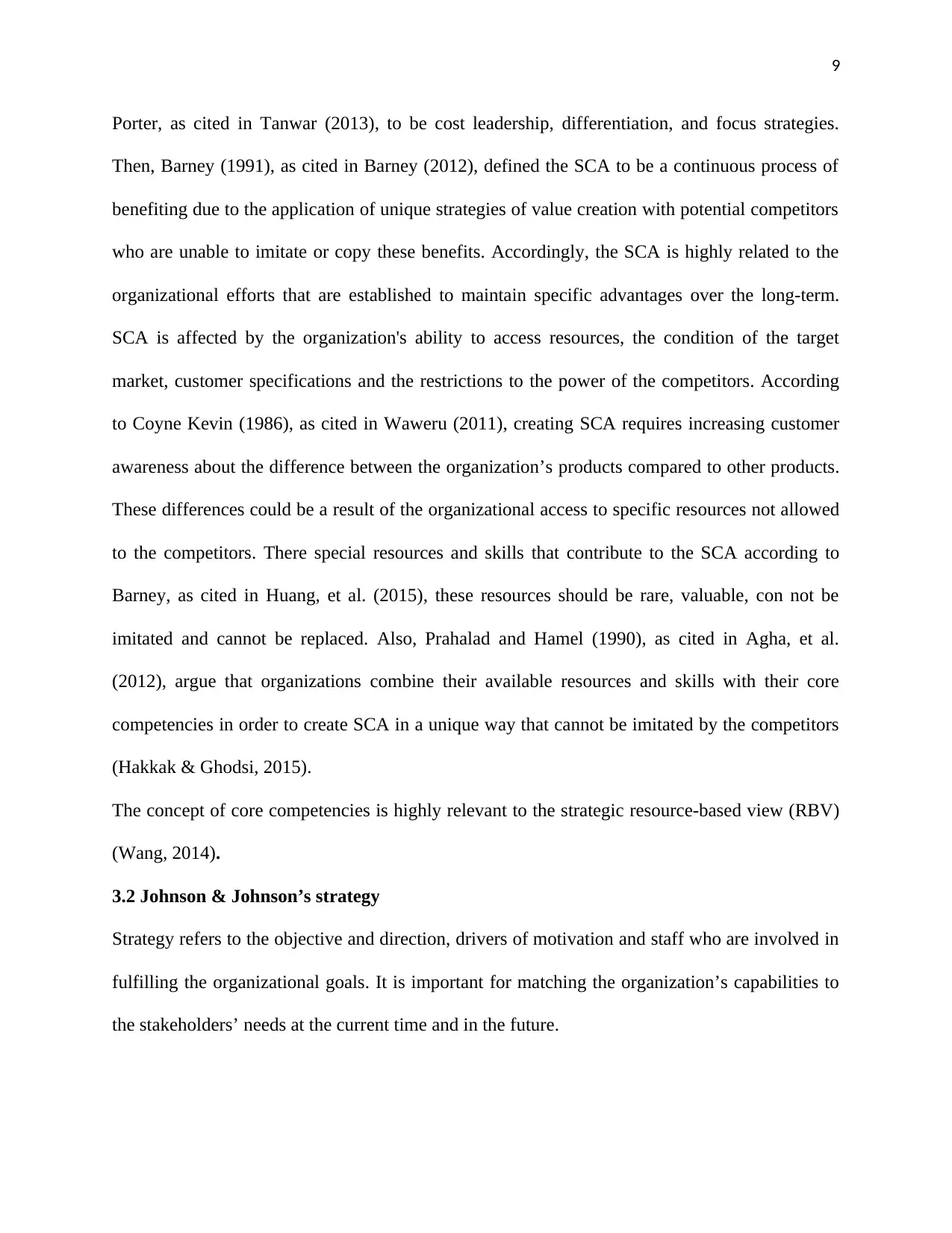
9
Porter, as cited in Tanwar (2013), to be cost leadership, differentiation, and focus strategies.
Then, Barney (1991), as cited in Barney (2012), defined the SCA to be a continuous process of
benefiting due to the application of unique strategies of value creation with potential competitors
who are unable to imitate or copy these benefits. Accordingly, the SCA is highly related to the
organizational efforts that are established to maintain specific advantages over the long-term.
SCA is affected by the organization's ability to access resources, the condition of the target
market, customer specifications and the restrictions to the power of the competitors. According
to Coyne Kevin (1986), as cited in Waweru (2011), creating SCA requires increasing customer
awareness about the difference between the organization’s products compared to other products.
These differences could be a result of the organizational access to specific resources not allowed
to the competitors. There special resources and skills that contribute to the SCA according to
Barney, as cited in Huang, et al. (2015), these resources should be rare, valuable, con not be
imitated and cannot be replaced. Also, Prahalad and Hamel (1990), as cited in Agha, et al.
(2012), argue that organizations combine their available resources and skills with their core
competencies in order to create SCA in a unique way that cannot be imitated by the competitors
(Hakkak & Ghodsi, 2015).
The concept of core competencies is highly relevant to the strategic resource-based view (RBV)
(Wang, 2014).
3.2 Johnson & Johnson’s strategy
Strategy refers to the objective and direction, drivers of motivation and staff who are involved in
fulfilling the organizational goals. It is important for matching the organization’s capabilities to
the stakeholders’ needs at the current time and in the future.
Porter, as cited in Tanwar (2013), to be cost leadership, differentiation, and focus strategies.
Then, Barney (1991), as cited in Barney (2012), defined the SCA to be a continuous process of
benefiting due to the application of unique strategies of value creation with potential competitors
who are unable to imitate or copy these benefits. Accordingly, the SCA is highly related to the
organizational efforts that are established to maintain specific advantages over the long-term.
SCA is affected by the organization's ability to access resources, the condition of the target
market, customer specifications and the restrictions to the power of the competitors. According
to Coyne Kevin (1986), as cited in Waweru (2011), creating SCA requires increasing customer
awareness about the difference between the organization’s products compared to other products.
These differences could be a result of the organizational access to specific resources not allowed
to the competitors. There special resources and skills that contribute to the SCA according to
Barney, as cited in Huang, et al. (2015), these resources should be rare, valuable, con not be
imitated and cannot be replaced. Also, Prahalad and Hamel (1990), as cited in Agha, et al.
(2012), argue that organizations combine their available resources and skills with their core
competencies in order to create SCA in a unique way that cannot be imitated by the competitors
(Hakkak & Ghodsi, 2015).
The concept of core competencies is highly relevant to the strategic resource-based view (RBV)
(Wang, 2014).
3.2 Johnson & Johnson’s strategy
Strategy refers to the objective and direction, drivers of motivation and staff who are involved in
fulfilling the organizational goals. It is important for matching the organization’s capabilities to
the stakeholders’ needs at the current time and in the future.
Paraphrase This Document
Need a fresh take? Get an instant paraphrase of this document with our AI Paraphraser
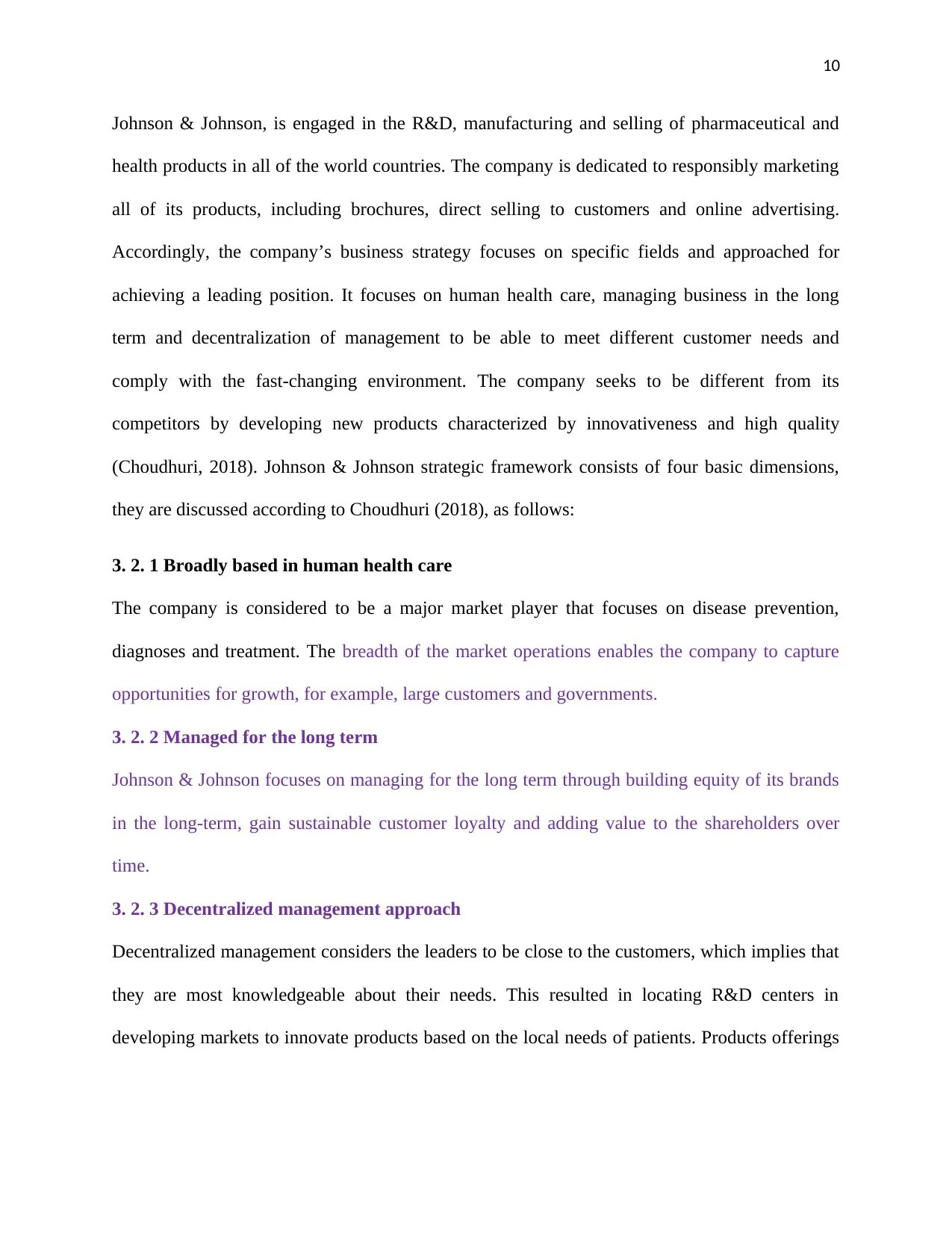
10
Johnson & Johnson, is engaged in the R&D, manufacturing and selling of pharmaceutical and
health products in all of the world countries. The company is dedicated to responsibly marketing
all of its products, including brochures, direct selling to customers and online advertising.
Accordingly, the company’s business strategy focuses on specific fields and approached for
achieving a leading position. It focuses on human health care, managing business in the long
term and decentralization of management to be able to meet different customer needs and
comply with the fast-changing environment. The company seeks to be different from its
competitors by developing new products characterized by innovativeness and high quality
(Choudhuri, 2018). Johnson & Johnson strategic framework consists of four basic dimensions,
they are discussed according to Choudhuri (2018), as follows:
3. 2. 1 Broadly based in human health care
The company is considered to be a major market player that focuses on disease prevention,
diagnoses and treatment. The breadth of the market operations enables the company to capture
opportunities for growth, for example, large customers and governments.
3. 2. 2 Managed for the long term
Johnson & Johnson focuses on managing for the long term through building equity of its brands
in the long-term, gain sustainable customer loyalty and adding value to the shareholders over
time.
3. 2. 3 Decentralized management approach
Decentralized management considers the leaders to be close to the customers, which implies that
they are most knowledgeable about their needs. This resulted in locating R&D centers in
developing markets to innovate products based on the local needs of patients. Products offerings
Johnson & Johnson, is engaged in the R&D, manufacturing and selling of pharmaceutical and
health products in all of the world countries. The company is dedicated to responsibly marketing
all of its products, including brochures, direct selling to customers and online advertising.
Accordingly, the company’s business strategy focuses on specific fields and approached for
achieving a leading position. It focuses on human health care, managing business in the long
term and decentralization of management to be able to meet different customer needs and
comply with the fast-changing environment. The company seeks to be different from its
competitors by developing new products characterized by innovativeness and high quality
(Choudhuri, 2018). Johnson & Johnson strategic framework consists of four basic dimensions,
they are discussed according to Choudhuri (2018), as follows:
3. 2. 1 Broadly based in human health care
The company is considered to be a major market player that focuses on disease prevention,
diagnoses and treatment. The breadth of the market operations enables the company to capture
opportunities for growth, for example, large customers and governments.
3. 2. 2 Managed for the long term
Johnson & Johnson focuses on managing for the long term through building equity of its brands
in the long-term, gain sustainable customer loyalty and adding value to the shareholders over
time.
3. 2. 3 Decentralized management approach
Decentralized management considers the leaders to be close to the customers, which implies that
they are most knowledgeable about their needs. This resulted in locating R&D centers in
developing markets to innovate products based on the local needs of patients. Products offerings
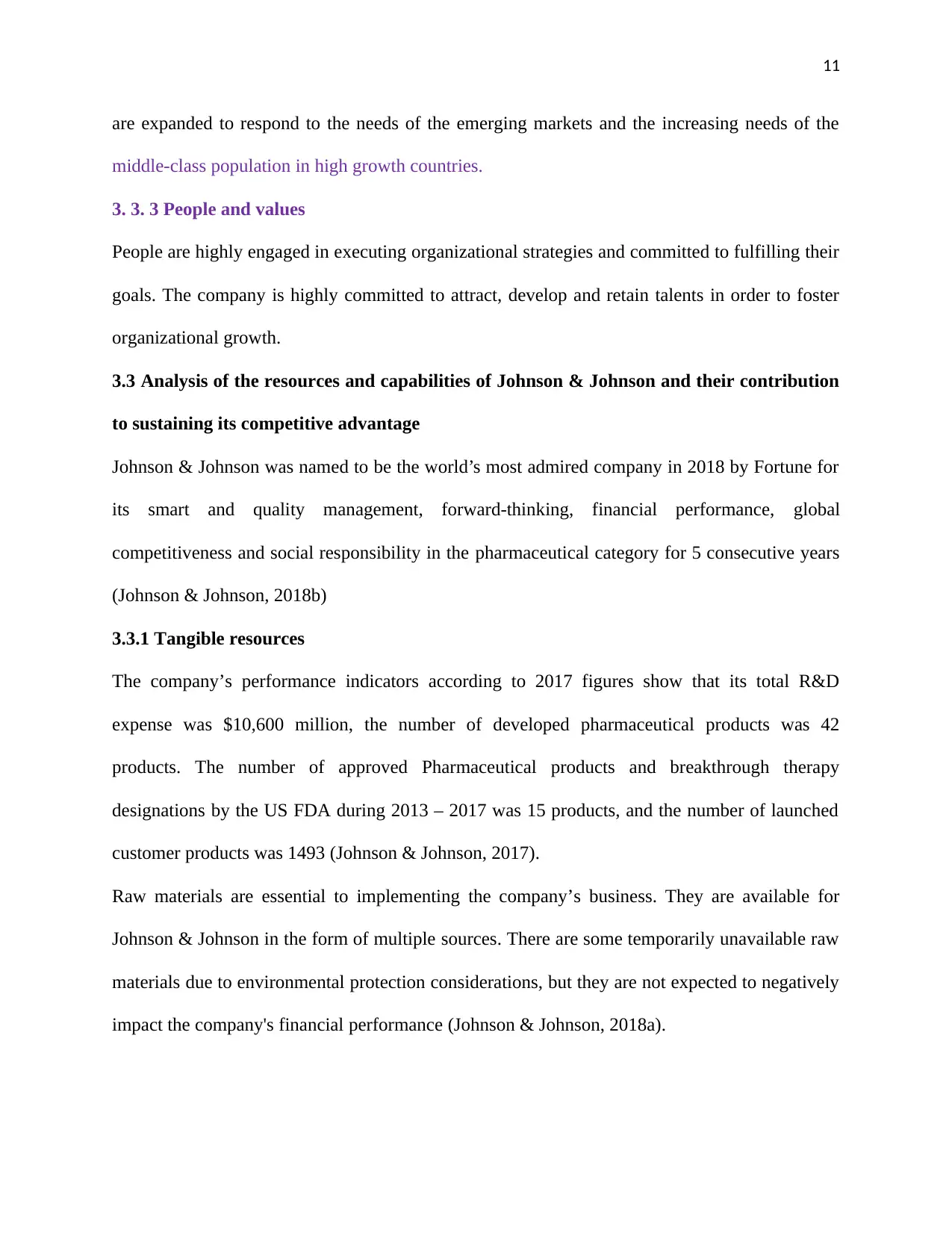
11
are expanded to respond to the needs of the emerging markets and the increasing needs of the
middle-class population in high growth countries.
3. 3. 3 People and values
People are highly engaged in executing organizational strategies and committed to fulfilling their
goals. The company is highly committed to attract, develop and retain talents in order to foster
organizational growth.
3.3 Analysis of the resources and capabilities of Johnson & Johnson and their contribution
to sustaining its competitive advantage
Johnson & Johnson was named to be the world’s most admired company in 2018 by Fortune for
its smart and quality management, forward-thinking, financial performance, global
competitiveness and social responsibility in the pharmaceutical category for 5 consecutive years
(Johnson & Johnson, 2018b)
3.3.1 Tangible resources
The company’s performance indicators according to 2017 figures show that its total R&D
expense was $10,600 million, the number of developed pharmaceutical products was 42
products. The number of approved Pharmaceutical products and breakthrough therapy
designations by the US FDA during 2013 – 2017 was 15 products, and the number of launched
customer products was 1493 (Johnson & Johnson, 2017).
Raw materials are essential to implementing the company’s business. They are available for
Johnson & Johnson in the form of multiple sources. There are some temporarily unavailable raw
materials due to environmental protection considerations, but they are not expected to negatively
impact the company's financial performance (Johnson & Johnson, 2018a).
are expanded to respond to the needs of the emerging markets and the increasing needs of the
middle-class population in high growth countries.
3. 3. 3 People and values
People are highly engaged in executing organizational strategies and committed to fulfilling their
goals. The company is highly committed to attract, develop and retain talents in order to foster
organizational growth.
3.3 Analysis of the resources and capabilities of Johnson & Johnson and their contribution
to sustaining its competitive advantage
Johnson & Johnson was named to be the world’s most admired company in 2018 by Fortune for
its smart and quality management, forward-thinking, financial performance, global
competitiveness and social responsibility in the pharmaceutical category for 5 consecutive years
(Johnson & Johnson, 2018b)
3.3.1 Tangible resources
The company’s performance indicators according to 2017 figures show that its total R&D
expense was $10,600 million, the number of developed pharmaceutical products was 42
products. The number of approved Pharmaceutical products and breakthrough therapy
designations by the US FDA during 2013 – 2017 was 15 products, and the number of launched
customer products was 1493 (Johnson & Johnson, 2017).
Raw materials are essential to implementing the company’s business. They are available for
Johnson & Johnson in the form of multiple sources. There are some temporarily unavailable raw
materials due to environmental protection considerations, but they are not expected to negatively
impact the company's financial performance (Johnson & Johnson, 2018a).
⊘ This is a preview!⊘
Do you want full access?
Subscribe today to unlock all pages.

Trusted by 1+ million students worldwide
1 out of 18
Related Documents
Your All-in-One AI-Powered Toolkit for Academic Success.
+13062052269
info@desklib.com
Available 24*7 on WhatsApp / Email
![[object Object]](/_next/static/media/star-bottom.7253800d.svg)
Unlock your academic potential
Copyright © 2020–2025 A2Z Services. All Rights Reserved. Developed and managed by ZUCOL.





